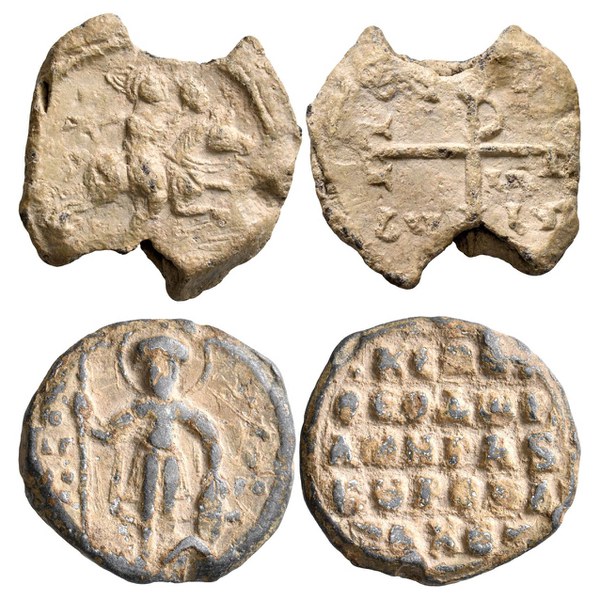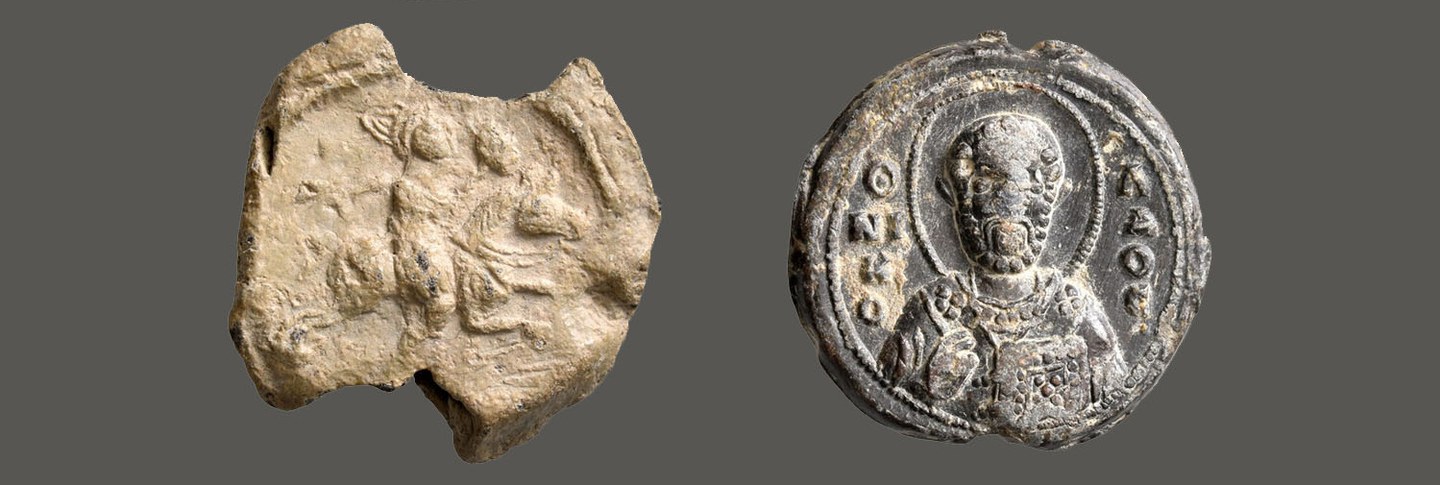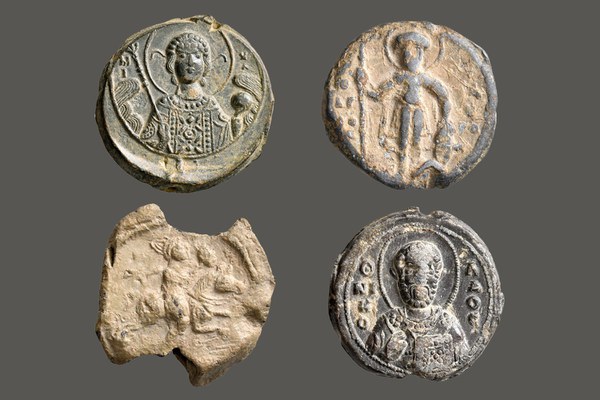By Julia Ostmann
Curious about what happens at Dumbarton Oaks when the museum closes and the garden gates lock? Our series “Behind the Scenes” uncovers the hidden activities, surprising jobs, and remarkable discoveries that make a home of the humanities.
Astride a galloping horse sits a beardless rider holding a message bag or scroll, accompanied by the monogrammed inscription “Andreas koubikoularios”—the name of a famed imperial eunuch from the mid-seventh century, when this bit of Byzantine lead was likely struck. Andreas was a successful general and a diplomat to the Umayyad caliphate, the eastern neighbor of Byzantium. A later chronicler wrote that when a fellow ambassador mocked Andreas for being a eunuch, he overtook him in the desert, tied him to a stake, and castrated him.
Four new lead seals including this one have joined the renowned 17,000-strong Dumbarton Oaks collection, commissioned by a cross section of Byzantine characters: this “potentially violent eunuch,” two Armenian soldiers, and a man petitioning Saint Nicholas with a poem, says Jonathan Shea, associate curator of coins and seals, who acquired the seals from two auctions in late 2019.*
The galloping rider delivering an important message stands out dramatically at a time when typical Byzantine seals featured only text or simple icons of holy figures. Scholars think the seal depicts Andreas himself. “Portraits of yourself are incredibly rare, unless you’re an emperor,” Shea says. Even rarer are images of palace servants and eunuchs, particularly ones they commissioned themselves. “We would never have a picture of this guy if not for a seal like this. It might be a small picture, but it shows him as a man of action, galloping to do the emperor’s bidding.”

In the Byzantine world, seals secured legal documents (such as wills, sales of land, and decisions of judges), official dispatches like the one Andreas could be carrying, bags of gold, and much else. But with their religious iconography and inscriptions, seals also called on the protection of divine intercessors. “It’s sort of a double layer of sealing,” Shea observes. “They become almost like talismans in that way."
Seals also reveal how people wanted to present themselves to their contemporaries. In the eleventh century, an Armenian soldier named Thoros, son of Hetoum, commissioned another of the new seals. After fighting for a Byzantine military unit, Thoros ended up commander of Edessa for the Seljuk Empire as it conquered swaths of eastern Byzantium. He chose a Byzantine-style seal with Greek words—writing his own name as Theodore Chetames, for instance, and adding the court title kouropalates—but recorded his position of emir with the Seljuk Turks.
“He’s showing he’s part of the Turkish world, part of the Byzantine world, but he’s actually ruling as an independent Armenian prince,” explains Shea. “You’re surrounded by two warring superpowers who both claim your territory. You're going to want to claim allegiance to both of them.” In the end, it was the Crusaders who killed Thoros.
Each of the new seals fills gaps in stronger areas of the collection. For instance, seals owned by Thoros and a duke of Antioch enhance an already rich assemblage relating to the Byzantine provinces and highlight underrepresented families, supporting active research into family names.

In the 1050s, another Armenian soldier named Katakalon Kekaumenos was appointed duke of Antioch, the most important city east of Constantinople, after rising from a relatively humble family to become a “phenomenally important man in the Byzantine army,” according to Shea. Famed for later joining a rebellion against the emperor and winning, Katakalon was not previously represented among Dumbarton Oaks seals. This example features probably the finest representation of the archangel Michael in the collection. His wings curl up at the edges, the unusually deep relief revealing details of his hair, face, imperial dress, globe, and scepter. “This one is just so perfect, it’s like the day it was struck,” marvels Shea, who plans to use the seal when teaching students.
Meanwhile, the fourth new seal offers a key addition to more than 1,500 metrical seals recently translated and made freely available online. Opposite a remarkably well-preserved image of Saint Nicholas, the owner inscribed a rare prayer directly to the saint (rather than to the Virgin or Christ) in the form of a twelve-syllable metrical poem: “fervent protector, help your servant Methodios.”
Who was Methodios? “We have no idea, and it’s unlikely anybody ever bothered to write about him,” Shea says. Like so many others in the collection, this late eleventh-century seal provides a “relic of a person lost otherwise.”
Seals “tend to disappear into private collections when they come up for sale,” Shea notes. By joining the Dumbarton Oaks collection and eventually the online catalogue, these four seals will illuminate the stories of Byzantine people for visiting K–12 and university students, future Coins and Seals Summer Program participants, museumgoers, scholars, and anyone with an interest and an internet connection. “That’s something that makes our collection special,” says Shea, “and I think a prime reason for trying to buy new material: so that it can be given back to the public.”
*Catalogue entries and accession numbers are pending, due to challenges from the ongoing COVID-19 pandemic.
Julia Ostmann is postgraduate writing and reporting fellow at Dumbarton Oaks. Photos courtesy of Leu Numismatik AG.

